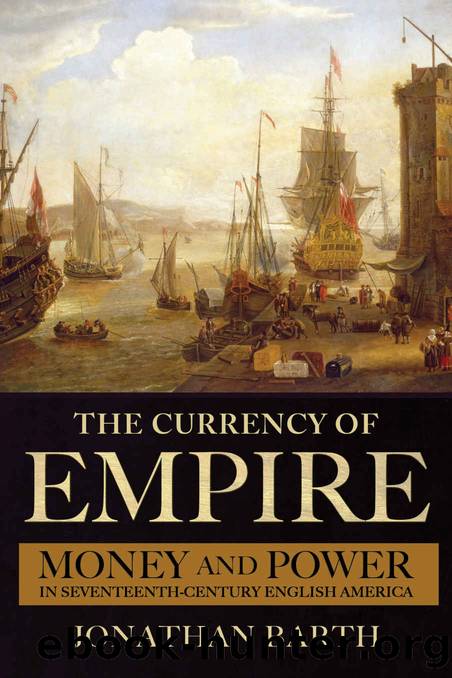The Currency of Empire by Jonathan Barth

Author:Jonathan Barth [Barth, Jonathan & Barth, Jonathan]
Language: eng
Format: epub
ISBN: 9781501755774
Publisher: Cornell University Press
Published: 2021-06-14T16:00:00+00:00
* * *
Buccaneers considered a host of factors when determining which North American seaport to visit. Was it a private colony or a royal colony? What was the reputation of the governor? What of the merchants? And how many shillings could a piece of eight earn there?
Colonial governments raised the value of Spanish money to new heights in the early to mid-1680s. Coin devaluation, indeed, became the most popular means in colonial America to attract foreign silver, whether from pirates or ordinary tradesmen. The timing conveniently, though not accidentally, aligned with the pirate ascendancy in eastern North America; pirates were more likely to bring their coin into a port for 6s apieceâor better yet, 6s9d apieceâthan, say, 5s apiece. Colonial leaders knew this fact well, and their governments, by consequence, actively competed over which province could offer pirates, merchants, tradesmen, and anyone else with coin the most bang for their buck.
In 1682, on the eve of this new devaluation wave, the rates for a Spanish dollar (piece of eight) were as follows: 4s6d in Maryland (the same standard as in England); 5s in Virginia, Carolina, Jamaica, and Barbados; 6s in New York, Massachusetts, and the Leeward Islands; 7s8d in New Jersey.34 Rates changed rapidly thereafter. In 1683 alone, four coloniesâPennsylvania, Connecticut, New Hampshire, and Carolinaâraised the piece of eight from 5s to 6s.35 The following year, 1684, the New York assemblyâmeeting for the first time in the colonyâs historyâadvanced the dollar from 6s to 6s9d. The new rate was 12.5 percent higher than in Massachusetts. James, Duke of York, elected not to repeal the new statute, but less than two years later, as king, he warned Governor Dongan that âyou shall not, upon any pretence whatsoever, permit any [further] alteration to bee made in the value of the current coyn.â36
To somewhat complicate matters, however, devaluation could also be secured more discreetly. By ordering clipped coin to pass at face value, some governments permitted colonists to accept Spanish money at rates higher than the law, at first glance, suggested. An unclipped piece of eight, if minted in Mexico or Spain (though not in Peru), contained 17.5 pennyweight (dwt) of silver. Clipped coin was often as light as 12 dwtâone-third lighter than a full-weight dollar. Yet during this period, a number of colonial governments declared clipped money legal tender at the same rate as full-weight coin, allowing clipped money to pass at face value. This method of valuation was called currency by tale, as opposed to currency by weight. Virtually all pirate money was clipped to some degreeâoften by the same piratesâand so governments that allowed clipped money to pass at the ordinary rateâcurrency by taleâsignificantly enticed buccaneers with clipped money. The opposite approachâcurrency by weightâdeployed a sliding scale of valuation, deducting a certain number of pence for each missing pennyweight from the coin. Pennsylvania, West Jersey, Barbados, and the Leeward Islands enacted currency by tale; New England, New York, East Jersey, and Carolina, currency by weight. The decision on which way
Download
This site does not store any files on its server. We only index and link to content provided by other sites. Please contact the content providers to delete copyright contents if any and email us, we'll remove relevant links or contents immediately.
Zero to IPO: Over $1 Trillion of Actionable Advice from the World's Most Successful Entrepreneurs by Frederic Kerrest(4064)
Machine Learning at Scale with H2O by Gregory Keys | David Whiting(3640)
Harry Potter and the Goblet Of Fire by J.K. Rowling(3612)
Never by Ken Follett(3533)
Ogilvy on Advertising by David Ogilvy(3338)
Shadow of Night by Deborah Harkness(3177)
The Man Who Died Twice by Richard Osman(2811)
Book of Life by Deborah Harkness(2721)
My Brilliant Friend by Elena Ferrante(2704)
How Proust Can Change Your Life by Alain De Botton(2615)
0041152001443424520 .pdf by Unknown(2599)
Will by Will Smith(2581)
The Tipping Point by Malcolm Gladwell(2562)
How to Pay Zero Taxes, 2018 by Jeff A. Schnepper(2503)
Purple Hibiscus by Chimamanda Ngozi Adichie(2493)
Hooked: A Dark, Contemporary Romance (Never After Series) by Emily McIntire(2423)
Rationality by Steven Pinker(2150)
Borders by unknow(2119)
Daughter of Smoke and Bone by Laini Taylor(2083)
